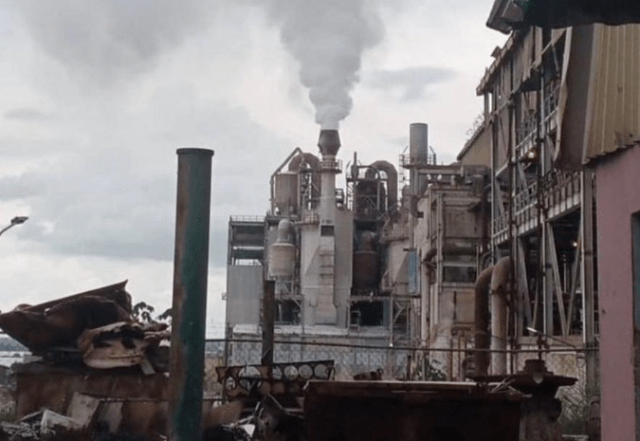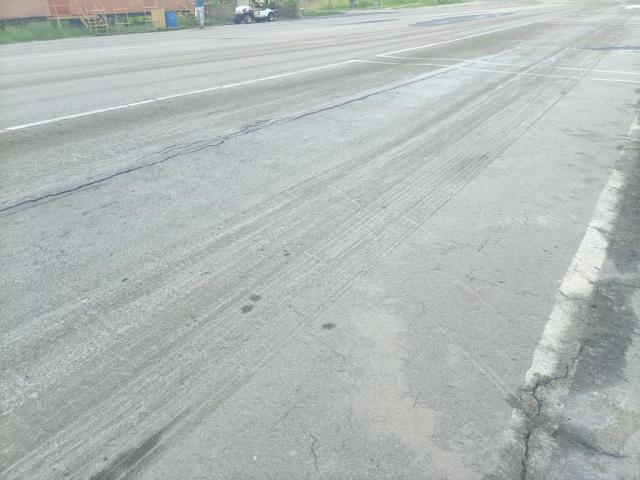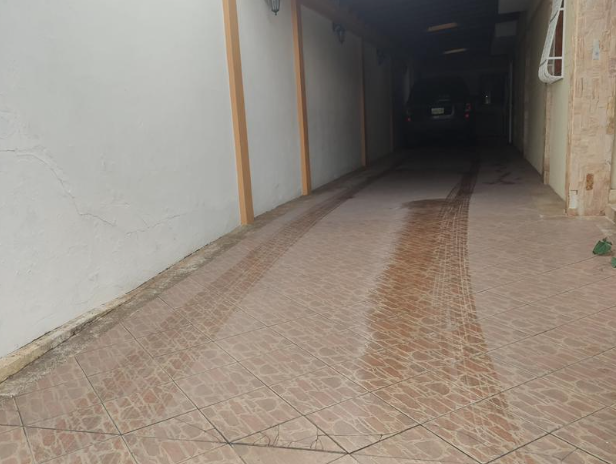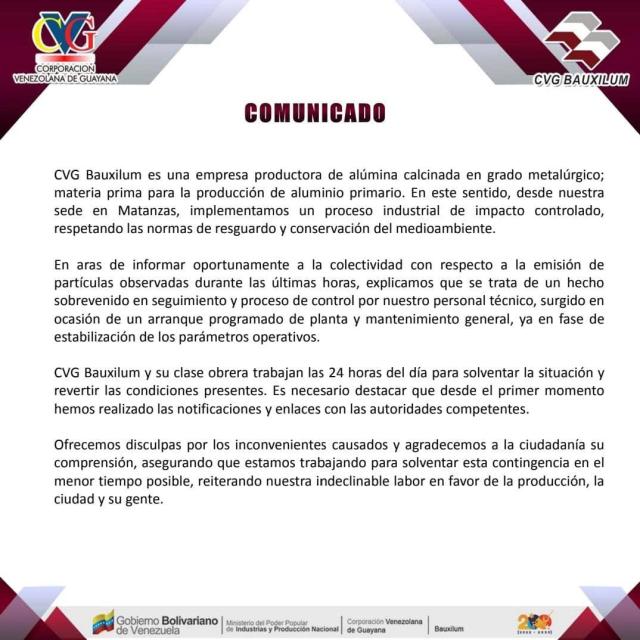
A billboard showing Nicolás Maduro and Hugo Rafael Chávez Frías welcomes to “CVG Bauxilum” (Government run corporation). It reads: “Socialist productive company” along with the following phrase: “Producing with quality. We Will Win!”. But that fence full of white powder is the perfect allegory of how Chavismo has pulverized a country.
Pableysa Ostos // Correspondent lapatilla.com
That powder is calcined alumina, which makes it clear that Bauxilum is not “producing with quality”, as advertised on the billboard. The particles have not only spread throughout the Matanzas Industrial Zone, but also to more than six residential areas in the city of Puerto Ordaz.
The problem began on Sunday, September 4th and has worsened as the days pass. The official statement came with some delay – 4 days later – through a statement published by the company through its social network accounts, without offering further details.
The Governor of Bolívar State, the Mayor of the Caroní Municipality and various regional representatives have remained silent, without addressing a situation that affects more than 100 families, as well as the workers of basic companies that belong to the national government.
A CVG Bauxilum worker, who preferred to keep her name anonymous, explained to a team of La Patilla that the workers are in a much more serious situation than that suffered by the people of the adjacent community in these last few days.
“They expose them without protection to these ultra-fine emissions and that material sticks to the lungs. Since last Tuesday, September 6th, they have instructed staff to wear masks, but this material requires the use of special 3M double-filter masks to be effective.”
The woman explained that the state company decided 4 years ago, specifically in 2019, not to carry out the two scheduled maintenance stops… “using those resources in other things, including political activities. The emulsion and washing agitator tanks began to ‘freeze’, this means that the mixture of bauxite with caustic soda hardens, and due to lack of maintenance, they begin to be taken out of service.”
The Situation Worsens

With those tanks out of service, there was an explosion in “calciner 1″, caused by the same maintenance deficiencies. “They wanted to start it up after a half-fix, but it just blew up. That calciner is still not working,” explained the worker with more than 20 years of service in the company.
“Remember that famous energy saving decree. Under that guideline, Bauxilum (Bauxite and Alumina refiner) crippled half of his tanks, and two entire lines of Venalum (Aluminum smelter) shut down as well. All of this with disastrous consequences for those plants,” explained the worker.
According to sources consulted, the production of Bauxilum began to decline, going from 1,600,000 tons down to 550,000. Production today it does not even reach 200,000 tons, in a plant with a design capacity of 2,000,000 tons.
“Now from the China-Turmero administration, given the unreliability of the supply and highlighting that this ultra-fine is not used to make aluminum, since it is considered out of specifications, because it is not possible for the electrolysis of the cells to dilute it in liquid aluminum, then Venalum began to import alumina, with its consequent “guisos” (lit. stews, shady deals). But they ran out of money, production continues to drop and they now force Bauxilum to produce, because it is the only one that would ever sell them on credit. Hence the order was to start the calciner at all costs. With ‘calciner 3’ working at half-capacity and 1 out of service,” the consulted sources explained.
Strong Investment

The interviewed workers agree that CVG Bauxilum requires nearly 44,000 tons of caustic soda just to put the washing tanks into operation to dilute the emulsion that solidifies, and that cannot be removed from the tanks even with a pneumatic hammer drill, because of its high silica content. It is a solid rock that sticks to the walls of the tank.
Bauxilum has 12 tanks in that condition and they have already begun to “scrap” some areas. These were dismantled to obtain funds by selling them as scrap, as was the case with Alcasa (Another government corporation). Those 12 tanks are only for washing, but the company has another 48 tanks for racking and emulsion bleaching, which is known as the “white side.”
The cost of soda per tank is approximately 62 dollars per ton and according to what the workers pointed out, there are no longer any willing suppliers available, “because in the market it is well known that Bauxilum does not pay and if they sell to them it is only in cash.”
They thoroughly explain that the calcination area is the final phase of the production process. The material that reaches this phase is aluminum hydroxide, which must be in a “coarse” emulsion to avoid ultra-fine emulsion and be able to remove water from the mixture applying a thousand degrees Celsius in the calciner.
“It is not only the issue of filtering to avoid emissions, it is the whole process. It must be within parameters so that when it is calcined, the level of fine material is minimal. To give you an idea: for aluminum plants, the fines content must be less than 0.2%. It is irresponsible to start these calciners, with high risks of explosion or other incidents that, God forbid, could claim human lives, through a process totally out of control,” they warn.
They explain that this whole process is done in phases, and once the previous phase has been completed successfully, the next one is carried out. “Let it be produced little, but safely. Nobody wants to go to certain areas anymore because of the risk of serious accidents. But since the board wants to present “outstanding” results, they do not care about the lives of the workers. Other warnings have already left several families mourning. Families who still today have not even had their benefits paid out and they have tried to pay the families with the monetary cone of 2018 (old replaced currency).
They point out that at CVG Bauxilum there are only two operating calciners, and still each of them requires an investment that ranges between 250,000 to 600,000 dollars, so that they can work properly.
Citizens, The Most Affected

Cars, garages, plants, entire houses have been covered by calcined alumina, a situation that has caused fear and health problems among those affected. Odalis Ruiz lives in the “Riberas del Caroní” neighborhood. She pointed out that her husband has had respiratory problems.
“This Saturday dawned all white. I already knew about the situation, but today the fallout was more accentuated. In my patio, the plants and the car already had some of that dust, but this Saturday morning it was worse. There is a lot of material outside the plant and if they don’t pick it up, the breeze will continue to spread that dust to nearby urban developments.”
Another resident, Yudith Moa, commented: “This is not a whim, it is a reality. The houses, the floors, the kitchens, the furniture, everything, everything covered by a white powder, as if it were lime, white cement. With that dust it is dangerous even to consume food, because everything is contaminated.”
“The other thing is that breathing is difficult. There are hours when you can’t even breathe, because the smell is in your room and throughout the house. Our throats, the hair. And this is not an imagined figment. You clean and after a while that dust is back, it is everywhere in our bodies,” said Moa.
Both women agree that it is a terrible health problem that the Bauxilum company is causing.
Health Damages
Some of the sectors affected by the calcined alumina leak are El Guamo, El Caimito, Paratepuy, Sierra Parima, Las Acacias, Villa Icabaru, Villa Betania, Las Casitas, Core 8, Unare. In short: all the areas surrounding the basic companies industrial complex.
Doctor Doris Odremán, who is an internist and clinical pulmonologist, pointed out that this is one of the most important and common occupational diseases. “It is common that in consultation we see patients with pneumoconiosis, which is what we call occupational disease caused by exposure to certain minerals. Aluminosis is also part of this group of respiratory occupational pathologies.”
“Not only does it affect the respiratory system, but this is one of the most frequent ailments and compromises the person’s health, and more so when exposure is prolonged. In this case, it was different because the exposure affects the communities and ‘supposedly’ the workers who are in the basic companies have respiratory protection systems, masks with a specific filter grade to reduce absorption, but there is always a residual effect,” warns Odremán.
He explains that in the communities that were affected, in these areas where their residents did not have any type of protection. “Aluminosys” is a pathology that affects, especially the respiratory system when an inflammatory reaction is generated from prolonged exposure to the calcined particles of aluminum and bauxite. When these particles are inhaled they compromise the entire respiratory tract, from the nasal mucous membranes, down the bronchi and entering the lungs producing a very severe inflammatory reaction.
“At the moment, the exposed worker or patient may present pneumonitis, but this evolves over time after prolonged exposure, until it creates fibrosis, that is, the hardening of the lung. These changes are irreversible, that is, a patient after sustained and prolonged exposure to alumina over the years can lead to pulmonary fibrosis, ” she added.
Medical Monitoring is Required
For her part, Dr. Elibeth Marcano, a surgeon and clinical pulmonologist, points out that it is “worrying because we do not know in what concentrations and what other components this powder has. It obviously causes irritation in people at the ocular level, allergies, in patients who already have a history of rhinitis. Among other things it can trigger asthma attacks, even in patients who do not have any history it can cause periods of allergies, conjunctivitis.”
She points out the importance of wearing face masks, any mask as a form of protection. She recommends the KN95 models that have a better filter capacity. “In patients who have a history (of pulmonary disease), it is important that they use their medications to prevent them from falling into a crisis. In patients a dry cough develops, or difficulty breathing, you should go to your trusted pulmonologist in time to avoid progression of these diseases.
“All this contamination can produce inflammation in the bronchial tree, causing acute bronchitis and in some cases chemical pneumonitis. The latter in those who are most exposed, that is, the workers,” says Marcano.

